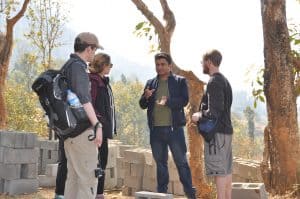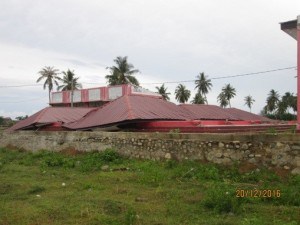An estimated 500,000 houses are only partially damaged after the 2015 earthquakes in Nepal. That means out of 750,000 houses estimated to be damaged or destroyed, 2/3 of them are still standing but cracked and unsafe for people to use. These homeowners are not in need of newly constructed houses, but an opportunity to save as much of their original house as possible and strengthen it through retrofitting. Retrofitting is an innovative and cost-effective method of seismically strengthening existing houses by strengthening structural elements and stabilizing the current structure,
Taking Time to Learn in Nepal
Contributed by Paul Wilson
It’s been 2 weeks, nearly to the day, since I returned from Nepal while I am writing this -although it’s hard to tell precisely given this is the third time zone I’ve been in during that time- but I do know that I’m 2 weeks late in writing this blog. Admitting my tardiness is exactly why the experience of the RMS Impact Trek is of such value.
On Being Women in Engineering
Women play a crucial role in post-disaster reconstruction. In Nepal, where the population is 51% female, this has become especially apparent. Many women have taken on new roles and responsibilities since the earthquakes in 2015, and are at the forefront of permanent reconstruction efforts to build a safer future for their families, communities, towns, and cities.
At Build Change, we have always placed a special emphasis on working with, hiring,
The Impact of Data in Recovering from a Natural Disaster
Contributed by Jeremy Zechar
Hello, dear reader from the future. Perhaps you’re reading this without context, so allow me to set the scene. In March of 2017, RMS invited me, an unsuspecting client, to join their Impact Trek to Nepal. Seven other trekkers and I visited Build Change, an organization whose Nepali operation seeks to help improve construction and retrofitting practices in the villages struck hardest by the April 2015 Gorkha earthquake.
Building Change in Nepal
Contributed by Amy Carter
Having just returned from the RMS Impact Trek in Nepal I felt encouraged to write about the tremendous work which Build Change is doing following the devastating earthquake in April 2015. My awareness of the charity only really came to light when RMS announced they would be organizing the impact trek and choosing three clients to take with them. I was lucky enough to be one of those three.
RMS Impact Trek Nepal 2017: Exploring Bhimtar and Eklephant
Contributed by Caroline Fox
On our first day in the field we headed up to Bhimtar, a rural fishing community about 45 minutes from the main road and where we are staying. Bhimtar was badly impacted by the earthquake, with most houses completely destroyed. Since the earthquake occurred just before midday on a Saturday, most people were down by the nearby river and children were not in school. All buildings in the village were destroyed,
Retrofit Type Design Approved: A Turning Point in Nepal’s Reconstruction!
An estimated 500,000 Nepali earthquake-affected homeowners in Nepal can now choose to retrofit their damaged homes. In doing so, an estimated 2.5 million lives would be made safe from future earthquakes and 30 megatons of construction materials, and 1 billion USD could be saved.
The National Reconstruction Authority (NRA) approved the retrofitting type design submitted by Build Change for stone masonry buildings in mud mortar on June 4th, 2017, after review by Technical Committee including representatives from the Ministry of Urban Development (MoUD) and leading Nepali structural experts.
RMS Impact Trek Nepal 2017: A Change in Perspective

After several days in Nepal, including two days in the field, my views have changed. My assumption was that everyone was building new homes to replace those destroyed by the 2015 earthquake, and that these new homes would be better, safer, and more capable of serving the needs of the people that lived in them. I thought this was simply an issue of technical skill, logistics,
Not Just Houses, but Homes: What it means to be “homeowner-driven”
Contributed by Hailey Mitchell
Have you ever thought about building your own house? Not just selecting the finishes, assembling IKEA furniture, or maybe laying a bathroom tile or two. I mean really starting from scratch: removing soil, mixing concrete (by hand), tying steel rebar, laying blocks… Would it change the way you felt about the building? Now imagine doing this in the wake of immense tragedy while you are living in a temporary shelter.
Surigao, Philippines: Examining Damages after the 6.7-magnitude Earthquake on February 10, 2017
From February 23 to February 25, 2017, Carl and Linnel from our engineering team in the Philippines performed post-earthquake reconnaissance following the 6.7 earthquake in Surigao Del Norte, on the north side of the island Mindinao. The team investigated and documented the response of rural school buildings and informal urban housing in the area, which will help inform our retrofit efforts in Manila and further our understanding of the seismic vulnerability of school buildings. The highest concentration of damaged housing exists in Surigao City,
Damages from the Pidie Jaya Earthquake: School Assessments and Checking in on Build Change-advised Houses
Day 4 – 22 December 2016 in Pidie Jaya District
Today we had a chance to join the government team that conducts assessments for school buildings. Their team is divided into three groups, each with an engineer from the Ministry of Public Works, and a representative from each of BPKP (Financial Investigation Agency of Aceh Province), BNPB, and DepEd Pidie Jaya. The team will assess 54 schools that are reported to have high or moderate damage by the school staff.
Aceh Earthquake Response Day 3: Brickmakers and Damaged Buildings in Meredeu & Bandar Baru Sub-districts
Today we visited two more affected sub-districts in Pidie Jaya. In the morning we went to Bandar Baru sub-district and visited two schools. The buildings are confined masonry, and include teacher housing. Walls have collapsed in a few of the classrooms and the library building.
The damage that we found in those two schools are quite similar to the damage at the schools we visited earlier in the week: cracks in the walls near windows and doors,
Damages from the Pide Jaya Earthquake Day 1: Bieruen District
Our reconnaissance team is composed of 3 Build Change staff and our driver Danu. Danny is the technical team leader for our current better brickmaking program in Lubuk Alung, West Sumatera. She also led the technical team in our previous technical assistance program in Aceh Tengah in 2015. Elwahyudi is a technical supervisor who is also currently involved in the better brickmaking program with Danny.
We left Sunday at noon from Padang and flew to Medan.
After Hurricane Matthew: Investigating Housing and School Damages in Beaumont & Les Cayes
Today we visited the city of Beaumont located between Jeremie and Camp Perrin in the mountains. We met the Mayor of Beaumont, who described a similar situation as that in Moron. The main street of the town was not very affected by the hurricanes. The majority of the houses and commercial shops are made from unreinforced masonry with heavy roofs. We went with a municipal agent to visit the outskirts of the town.
After Hurricane Matthew: Assessing Damages in Moron
Today we drove from Jeremie toward the mountains in the middle of the Grande Anse department. On the bumpy road along the Grande Anse River we saw dozens of houses with heavy damages from the hurricane. The houses are mainly constructed with a wood frame and stone masonry. The wind force shocked the buildings, provoking the fall of the top corners of some walls and cracks near the column joints. The use of mud mortar to place the stones is insufficient to tie the stone together well.
RMS Impact Trek: Day 1 – The Other Side of the World
Nepal. The mere mention of the word conjures images of the lofty, snow-covered Himalayas and towering Mount Everest. Here in Kathmandu, the world of the Sherpa feels as far away from me as everything else that is familiar and known.
Now half a world away from home, I find I’m rediscovering my inherent and natural senses. New smells, strange tastes, constant sounds, bright colors, and the feel of the humid air on my skin all feel new,
Saving Lives through Retrofitting in Colombia
Click here for link to Autodesk Foundation video.
“We can build buildings to withstand earthquakes. The knowledge and technology are out there. We just have to make it accessible to everyone.” – Elizabeth Hausler Strand, Founder & CEO, Build Change
In Colombia, we are working with city governments, the private sector, and homeowners to repair and strengthen homes before the next earthquake strikes. Retrofitting saves lives by ensuring that houses will protect families and children from future natural disasters.
Second Strong Earthquake in Nepal: Build Change Team Unharmed
A second strong earthquake struck Nepal on May 12, 2015. We are relieved to report that our team reported in and they are unharmed. The families in the small village they were in when it struck are also unharmed.
“We are all fine. At the time of the first M7.3 earthquake near noon, we were in a very remote village, Thulo Guan, Balthali, an hours’ drive from Kathmandu on a rutted,
Community Education in Takengon, Indonesia
Over 150 adults and 100 children participated in our Better Building Material community event in Takengon, Indonesia in December 2014. We have been working with 200 local brick-makers, mostly women, to help them produce better quality bricks.
Houses and schools built with poor-quality bricks or concrete blocks are likely to collapse during natural disasters. Better bricks and concrete blocks make safer houses and schools.
We provide on-the-job training for small businesses that manufacture bricks and blocks to improve the quality of their products.
- Page 2 of 2
- 1
- 2






